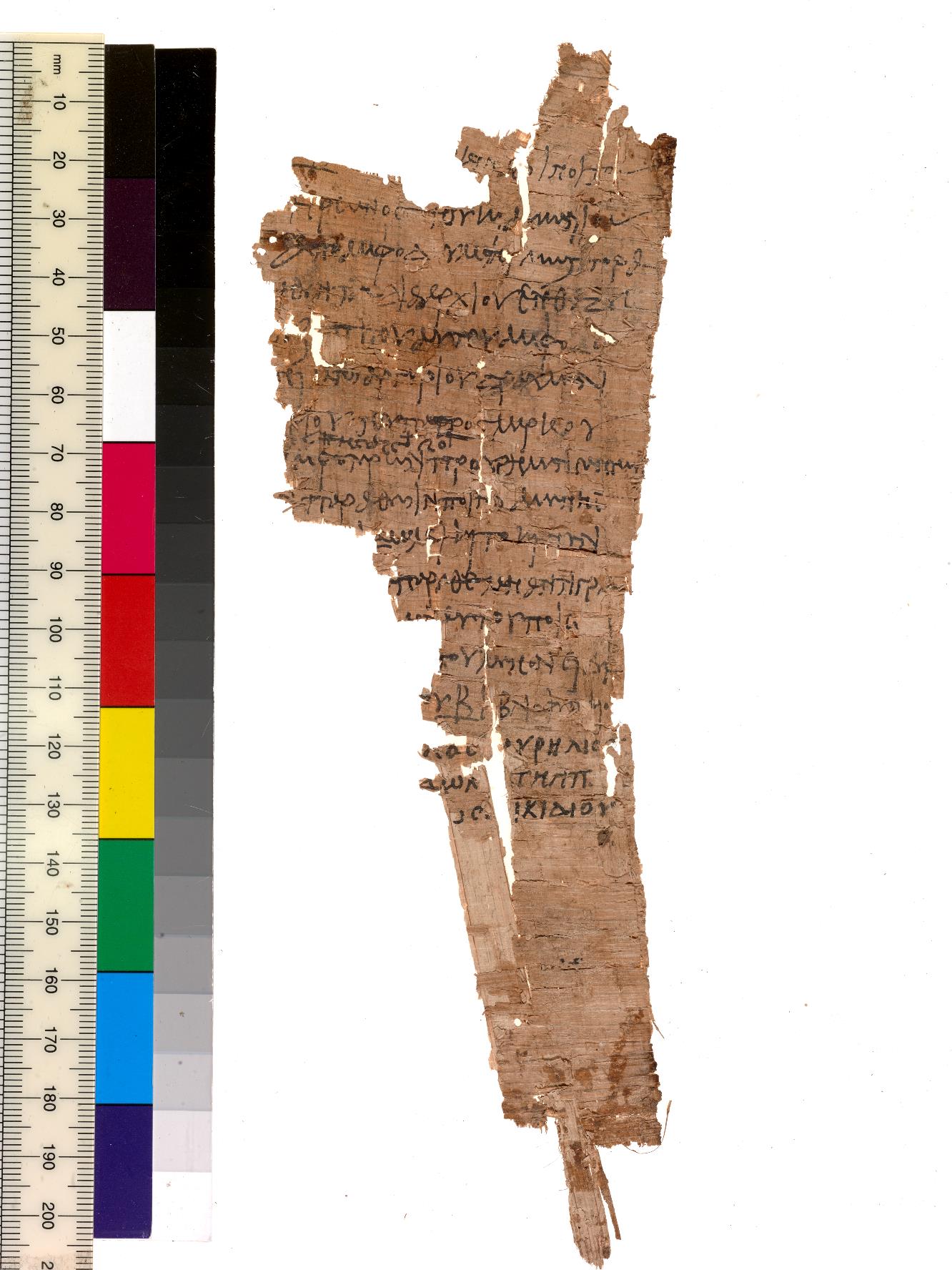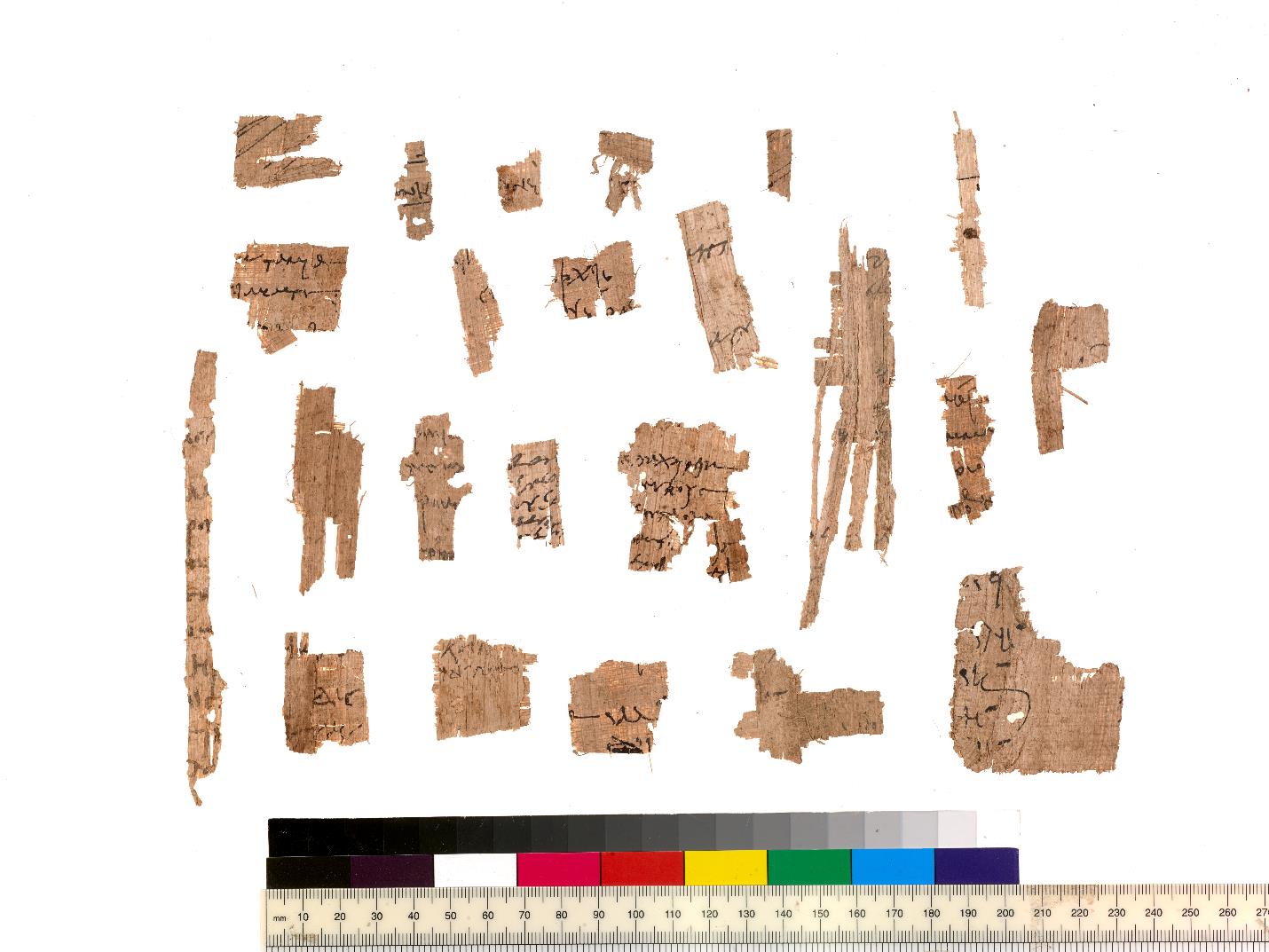This week I have been working on reading and interpreting the papyrus fragment pictured below (P.Mich.inv. 5451f), which was found along with a number of other objects outside the east wall of C65.

When looking at a new document for the first time, I first start with some initial impressions so I have some idea of what to expect when I start reading in detail. The papyrus is irregularly broken off at the left edge in the middle of words, but the ends of the lines seem to be preserved at the right edge. Parts of both a top and bottom margin are also preserved, which suggests that we have the beginning and the end of a short document. The style of the handwriting suggests that this is a documentary text rather than a literary one: the shape and formation of individual letters varies more than is usual in a literary text and many letters are joined with the following letter (‘ligatured’).
Next, I try to read as much of the preserved text as possible. Two aspects of ancient scribal practice which make this difficult are, firstly, that scribes writing Greek did not usually put spaces between words; secondly, abbreviations were commonly used to save time and these are not always straightforward to interpret. Complications can also be caused by the imperfect preservation of the papyrus: the surface can be abraded or the ink can be faded or smudged. However, not all these problems are insurmountable: if there is dirt on the surface of the papyrus, small folds round the edges or fibres out of place, the conservator at the Papyrology Collection, Marieka Kaye, can help make the text more readable.
Once I have read as much of the surviving document as I can, my next task is to try and fill in the missing parts of the text using other similar documents. Two papyri I have been finding useful so far are a papyrus from Tebtynis now kept in Oslo (SB VI 9625), and another papyrus housed in the Michigan collection but which was not excavated in Karanis (P.Mich. XII 627). Many of the documents we find on papyri are written in a very formulaic style, which helps a lot with restoring the text in places where the papyrus is damaged or the scribe’s handwriting is difficult to read. For example, in line 7 of 5451f I can read ]ρίου τοῦ πατρὸς Μάρκου, but the first word is broken off. After searching electronically through the text of many other papyri for the string ρίου τοῦ πατρὸς, I found that the most likely restoration for the part of the text which is broken off is μετὰ κυ]ρίου τοῦ πατρὸς Μάρκου. This tells us that someone involved in this document is acting with their father Marcus as their legal guardian. Another way I can sometimes restore an incomplete text is by finding additional fragments of the papyrus in the collection. I’ve spent some time sifting through the fragments found in the same location as 5451f looking for anything with similar handwriting which might be part of the same text. So far I haven’t found anything, but there are lots of tiny fragments to look through so I might get lucky later on.

All through this process, I have also been keeping an eye on ways to connect this text with other papyri from Karanis and beyond, usually through names of people and places mentioned in the text. Papyri are often most interesting when we have a group of texts about the same person or family. Unfortunately all the names I have been able to read in 5451f so far are not very distinctive, but this may change as I spend more time on the more hard-to-read parts of the text. I am also keeping in contact with the other papyrologists in the group, as different people can often solve different problems in a text, so it’s beneficial to have multiple sets of eyes on a document. The eventual goal is to produce an edition of the papyrus, containing a text and translation of the fragment as well as an introduction and commentary discussing important features of the document. This enables other researchers to use the text on the papyrus without having to go through the laborious and time-consuming process of reading and interpreting it from scratch.
So what information can be gleaned from 5451f so far? The document is a parathesis, a provisional registration document indicating that a sale (likely a sale of land) has taken place, and that the new owner of the property wishes to ensure the priority of their own claim before the sale has been definitively processed. We can also tell that the person who had the parathesis drawn up is a woman, even though her name is not preserved, because she is operating with her father Marcus as legal guardian in line 7, and because of a feminine participle ending in line 9. However, many questions still remain: what property did this woman purchase, and who sold it to her? How much did it cost and when did the transaction take place? Some of these will hopefully be answered by further study of the text and research into its context, but some will likely remain a mystery unless other information comes to light. Another ongoing puzzle about this text is where exactly it was found, as the record of objects from the excavation describes the find spot only vaguely as “outside east wall of C65 but above walls of lower period courtyard”. I am currently reading through the manuscript of Peterson’s original report on the site to see if I can find more precise information about the location where the papyrus was found. Knowing more about the find location, as well as what other objects were found nearby may help us decide if and how this document was related to the activities of C65: for instance, whether it was discarded as rubbish while the granary was still operational, or whether it accumulated after it was no longer in use.


